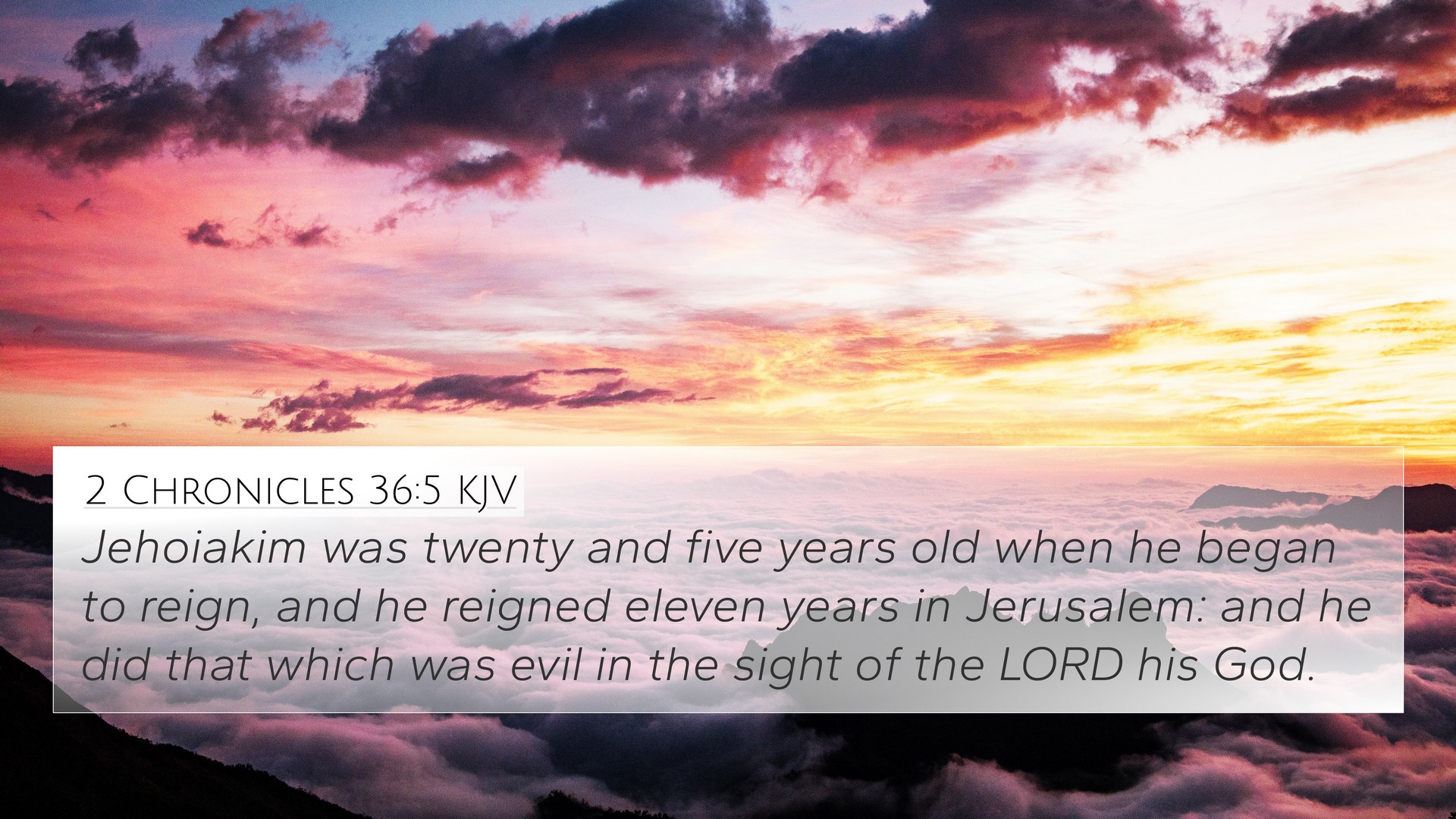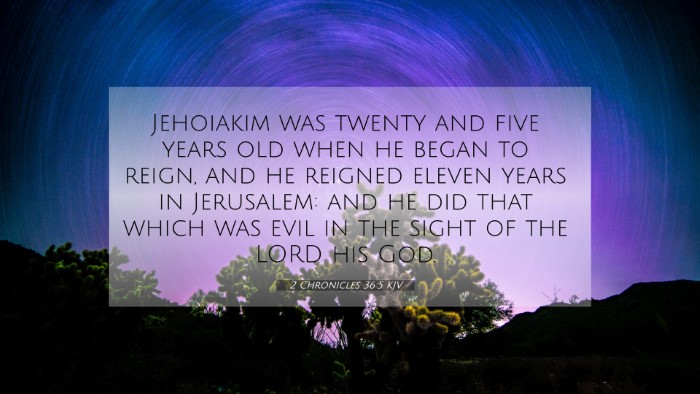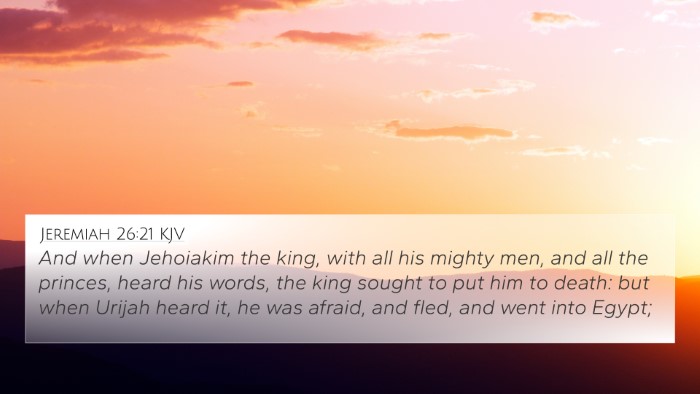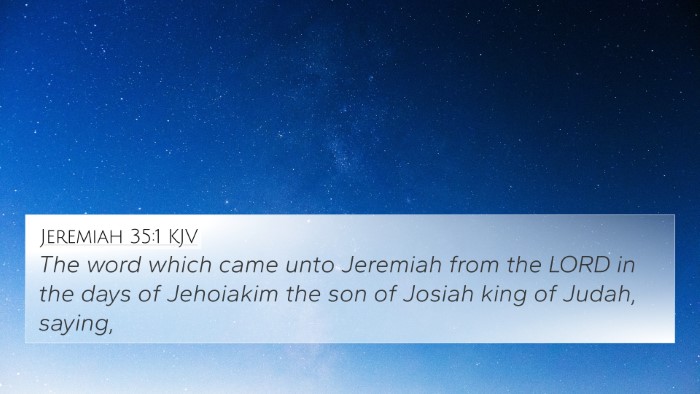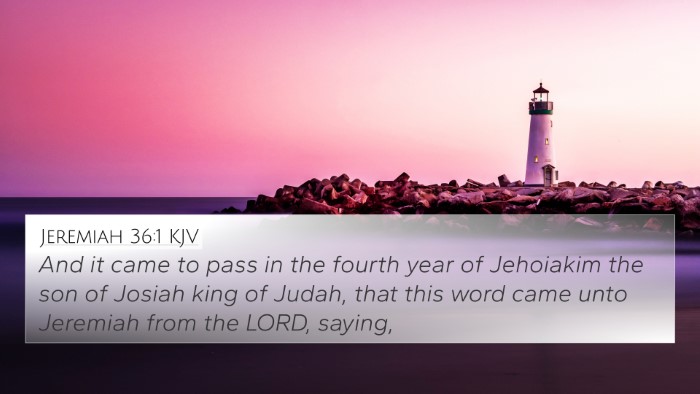Understanding 2 Chronicles 36:5
The verse 2 Chronicles 36:5 states:
"Jehoiakim was twenty-five years old when he became king, and he reigned eleven years in Jerusalem; and he did evil in the sight of the LORD his God."
This verse succinctly summarizes the reign of King Jehoiakim, highlighting his age, the duration of his rule, and his moral character as evaluated by God.
Key Themes and Insights
- Age of Ascension: Jehoiakim's immediate recognition as a leader at just twenty-five reveals the dynamics of leadership and the expectations placed upon young rulers.
- Duration of Reign: The eleven years of his reign signify both a period of stability and a time for reflection on his governance and its consequences.
- Evil in the Sight of God: This phrase sums up the tragic moral failure of Jehoiakim, illustrating a consistent theme throughout the scriptures regarding divine judgment.
Biblical Cross-References
To explore deeper connections between 2 Chronicles 36:5 and other scriptures, consider the following cross-references:
- 2 Kings 23:36-37: A parallel account highlighting Jehoiakim's reign and his building of a negative legacy.
- Jeremiah 22:18-19: God's prophecy concerning Jehoiakim, noting the fate of those who do evil.
- Isaiah 29:13: The heart posture of the people and their leaders and how it affects divine judgment.
- Daniel 1:1-2: Prophecy fulfilled through the events leading up to Jehoiakim's rule, showcasing God’s sovereignty.
- 2 Chronicles 24:17-19: The subsequent results of corrupt leadership in Israel.
- Proverbs 14:34: Righteousness as a nation’s exaltation in contrast to sin as a reproach.
- Romans 1:18: The theme of divine judgment upon ungodliness, resonating with Jehoiakim’s choices.
Thematic Connections
As we consider the implications of 2 Chronicles 36:5, we recognize significant thematic connections with:
- Leadership and Responsibility: The case of Jehoiakim serves as a backdrop for discussing the weight of leadership and the inevitable accountability to God.
- Divine Judgment: Parallel passages elucidate that God does not take lightly the wickedness of leaders, establishing a theme present throughout scripture.
- Historical Context: Understanding Jehoiakim’s place in history promotes a comprehensive interpretation of the biblical narrative.
Inter-Biblical Dialogue
Jehoiakim's negative example sparks discussions within both the Old and New Testaments, as various authors draw on his failure to convey broader moral lessons, including:
- Prophetic Warnings: The warnings given by prophets during Jehoiakim’s reign remain relevant in the New Testament’s themes of repentance and judgment.
- Jesus' Teachings: Parallels between Jehoiakim’s rebellion and New Testament discussions of true leadership and righteousness can be insightful.
Conclusion
2 Chronicles 36:5 presents a sobering reminder of the consequences of evil leadership and sets the stage for understanding God's justice. By studying this verse alongside its cross-references and thematic implications, we can cultivate a deeper understanding of biblical principles regarding leadership, righteousness, and divine accountability.
Tools for Further Study
For those seeking to explore the connections between the Bible verse and related scriptures, consider utilizing:
- Bible Concordance: A tool for finding keywords used in scripture and their occurrences.
- Bible Cross-Reference Guide: A resource that links verses thematically and contextually.
- Bible Reference Resources: Comprehensive materials that assist in tracing themes across scripture.
